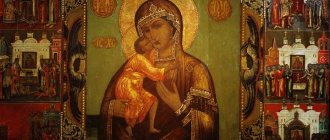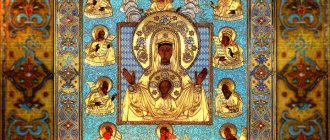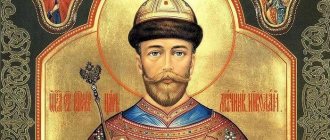The ability to read and write used to be a much greater privilege than it is now. Therefore, images were used to disseminate and explain certain religious ideas. Therefore, the crucifixion icon was often called the depicted Gospel or the Gospel for the illiterate. Indeed, in this image believers could see some basic details and symbols of faith. The composition was always rich and gave people the opportunity to think about Christianity, and Christians to be more inspired and inspired by faith.
Description and plot of the icon “The Crucifixion of Jesus Christ”
In icon painting, two versions of the Crucifixion of the Savior are used. Both stories are based on facts set out in the Gospel. The difference lies in the emphasis of the tragic event and the compositional structure.
In the first case, this is a reflection of the fulfillment of the will of the Lord. The death of the Son of God was predetermined before his birth in order to save the human race. A painful execution is atonement for sins, an opportunity for pious Christians to enter the Kingdom of Heaven and gain eternal life after the Last Judgment.
After 3 days, according to prediction, Jesus will resurrect and leave the earth, reuniting with God the Father on the throne in the Kingdom of Heaven. On a golden background they depict a seven-pointed cross with the crucified Jesus Christ, the Virgin Mary and the Apostle John. At the base of the cross, an open cave with the remains of Adam is visible.
The allegorical meaning of the picture of the ashes of the progenitor of people is that the blood of Jesus washed away the original sin he committed. Some images depict women next to the Most Holy Theotokos (Mary Magdalene and Mary of Cleopas), who, according to legend, were present at the execution. One of them supports the Mother of God, the other collects the blood of Jesus (the Holy Grail) into a chalice.
The second option corresponds most closely to the Gospel text. In the center of the icon is a cross with the crucified Jesus Christ. To the right and left are crosses with crucified robbers. At the top of the icon there are angels with mournful faces and two rocks. At the foot of the cross, believers see the figures of the Mother of God, the Apostle John the Theologian, and three Roman legionnaires. The composition can be complemented by women supporting the Mother of God and human figures.
The symbolism of the icon is an illustration of the apostolic stories about the execution of the Teacher. The execution of Jesus ended with an earthquake, as indicated by the rock images. The dark general background corresponds to the time of day when Christ died a painful death. The dynamics of the image are given by the reduced sizes of the figures of guards, robbers, gestures of the Virgin Mary, and angels.
The Italian (Catholic), Byzantine and Russian traditions of depicting the execution of Jesus have differences in details. On Orthodox icons, each limb is nailed with a separate nail. In Catholic images, the Savior's legs are crossed and nailed with one nail.
On Russian and Greek icons, the head of Christ is tilted slightly to the side, the palms are open, the body seems to have no weight. Catholic images are more naturalistic: the body of Jesus is depicted sagging in his arms, his head resting on his chest.
The “Crucifixion of Jesus Christ” icon corresponds in its meaning to the “Creed”. Parishioners who did not know how to read and write saw a visual illustration of the Gospel, thanks to which the meaning of the services during Lent and Easter was clearer.
History of the icon
The history of the creation of the “Crucifixion of Christ” icon is connected with the spread of the famous gospel story. This was especially important in those times when the bulk of the population remained illiterate, and therefore did not have the opportunity to read the Gospel, but the icon telling about the crucifixion made it possible for absolutely anyone to learn about the life, death and resurrection of Jesus Christ.
Icon "Crucifixion of the Lord"
It would be appropriate to remember that in those ancient times only the worst criminals were punished by crucifixion. This type of execution was quite common and the cross on which the criminals accepted death did not have any symbolic meaning, but was perceived as part of the execution, as its instrument.
The crucifixion of Jesus Christ is one of the frequently recurring themes not only in icon painting, but also in painting in general. For different artists, at a certain point in their lives, this common plot appears in completely different, sometimes even allegorical, forms. Thus, the “passion of Christ” is found in the works of such famous artists as Viktor Vasnetsov, Vasily Vereshchagin, El Greco, Francisco Goya and others. Of course, iconographic images, unlike paintings, are canonized and sanctified, therefore, in addition to their semantic load, they carry a special, invisible light that helps a person who has turned to the holy face of Christ to cope with various kinds of difficulties.
Read about Christ:
- Suffering on the Cross of Jesus Christ
- Death of Jesus Christ
- What nationality was Jesus Christ
Meaning and veneration in Orthodoxy
The icon of the Crucifixion of Jesus Christ is found in every Orthodox church. She is the first thing that catches your eye when entering the church. The sacred image has a deep meaning: the Son of Man, having gone through the torment of death, was reborn as the Son of God, giving people hope for eternal life.
In Orthodoxy, there are special dates for the veneration of icons of Jesus Christ. The troparion and liturgy are read at the beginning of the Dormition Fast (August 14), the Transfiguration of the Lord (August 19), in memory of the arrival of the Savior Not Made by Hands in Constantinople (August 29).
What do they ask for before the image?
The image of the crucified Christ makes a deep impression on a believer. They pray in front of the icon when they want to repent of sinful thoughts and deeds. There is a special “Prayer of Repentance,” which is read in front of icons with images of the Savior’s face.
Prayer requests help strengthen oneself in the Orthodox faith and follow Christian commandments:
- be patient;
- merciful;
- responsive to others.
In the morning and before going to bed, you should read a prayer in front of the holy image. In prayer, they ask the Savior for protection from ill-wishers, cure for illness, and spiritual strength.
Texts of prayers before the icon of the crucifixion of Christ
Prayer requests must come from a heart freed from envy, malice, and hatred.
Jesus Crucified
Lord Jesus Christ, Son of the living God, Creator of heaven and earth, Savior of the world, here I am, unworthy and most sinful of all, humbly bowing the knee of my heart before the glory of Thy Majesty, I sing praise to the cross and Thy suffering, and thanksgiving to Thee, the King of all and God, I offer, as you have deigned to bear all the labors and all kinds of troubles, misfortunes and torments, like a man, so that you will all be our compassionate Helper and Savior in all our sorrows, needs and embitterments. We know, Omnipotent Master, that all this was not needed by You, but for the sake of human salvation, that You might redeem us all from the cruel work of the enemy, You endured the Cross and suffering. That I will repay Thee, O lover of mankind, for all that Thou hast suffered for me for the sake of a sinner; We don’t know, for soul and body and all that is good are from You, and all that is mine is Yours, and I am Yours. Just in Your innumerable Lord, I trust in Your mercy, I sing Your ineffable long-suffering, I magnify Your inscrutable exhaustion, I glorify Your immeasurable mercy, I worship Your most pure Passion and, lovingly kissing Your wounds, I cry out: have mercy on me, a sinner, and make me not barren in I receive Your Holy Cross, so that by sharing Your sufferings here with faith, I may be worthy to see the glory of Your Kingdom in heaven! Amen.
Holy Cross
Save, O Lord, Thy people, and bless Thy inheritance, granting victories to the Orthodox Christians against the opposition, and preserving Thy life through Thy Cross.
Troparion to Jesus Christ Crucified
Tone 1 Save Thy people, O Lord, and bless Thy inheritance, granting victories against resistance and preserving Thy life through Thy Cross.
Chapter 9. Crucifixion
The suffering and death on the cross of Jesus Christ became a new revelation about God and His relationship with people. Christianity revealed to man a God who does not look indifferently at his suffering, but who Himself enters into the midst of human suffering, taking it upon Himself and dying for people. This is not the God whom deist philosophers preach: who created the world, established natural laws in it, but then withdrew and left the world to develop in accordance with these laws.
The Old Testament God actively intervenes in human life, performs signs and wonders, but at the same time remains distant and inaccessible, unattainable, incomprehensible and invisible, causing fear, awe and horror. The New Testament Revelation very significantly complements this image of God and reveals it in a new way.
In Jesus Christ, the invisible God became visible: He was revealed to people, so that through the human face of Jesus they could see the invisible face of the Father. That is why Jesus says to Philip at the Last Supper: He who has seen Me has seen the Father.
(John 14:9).
Through Jesus Christ, people came to know God as a Father - merciful and loving, but at the same time expecting from man unquestioning obedience to His will, in the image of that which the Son of God showed, being obedient even to death, even the death of the cross
(Phil. 2:8 ).
The death of the Son of God on the cross lifts the veil of secrecy over the relationship between the Father and the Son. When the Son of God suffered on the cross, did the Father suffer along with the Son? Did the cross of Christ relate only to the destinies of the people for whom it brought redemption, or did it relate to the inner life of God Himself? To try to answer this question, let us recall one biblical story, which in the Christian tradition is considered as a prototype of the death of Christ on the cross: the sacrifice of Abraham.
This plot, which is of particular significance for understanding the meaning of the story of the Passion, unfolds slowly over several chapters of the book of Genesis. They tell how God promises hundred-year-old Abraham and his barren wife Sarah to give him a son, how the elderly spouses wait for many years for the promise to be fulfilled, how a long-awaited son is born, and how then, when the boy grows up, God tempts Abraham and says: Take your son, your only one whom you love, Isaac, and go to the land of Moriah and there offer him as a burnt offering on one of the mountains that I will tell you about.
Having received this command, Abraham sets off on the journey with his son and servants.
On the third day, he sees from afar the place indicated by God and says to the servants: Stay here with the donkey, and my son and I will go there and worship.
Neither the servants nor the son questioned these words, since climbing the mountain to worship God was a common practice.
Only when Isaac sees that Abraham did not take the sacrificial animal with him, he asks his father: Here is the fire and the wood, where is the lamb for the burnt offering?
Abraham answers:
God will provide for Himself a lamb for a burnt offering, my son.
Finally, father and son come to the place indicated by God, Abraham binds Isaac, places him on the altar and raises a knife over him to stab him.
At this moment he hears the voice of an angel: Do not raise your hand against the boy and do nothing to him, for now I know that you fear God and have not withheld your son, your only son, for Me
(Gen. 22:2-12) .
In this story, both Abraham and Isaac appear as executors of the will of God. But if Abraham knows this will, then Isaac completely submits to the will of his father, despite the fact that his father’s act is in blatant contradiction with common sense, the norms of universal morality and the traditional family way of life. We do not hear any protest from Isaac’s lips, only one perplexed question. He lies down on the altar silently, accepting what is happening as the will of God, which for him coincides with his father’s. The Bible says nothing about the feelings and experiences that Abraham could experience at that moment when he had to shed the blood of his only and dearly beloved son with his own hands. The entire story is dominated by the image of God and the theme of His will, which requires from a person not only unquestioning obedience, but also a willingness to sacrifice the most precious thing he has.
How is the described biblical story projected onto the story of the suffering and death of Jesus Christ?
In the story of the Passion, the Son of God appears before us, who from the very beginning knows that he came to become a sacrifice for the redemption of many
(Matthew 20:28; Mark 10:45).
He knows that He must do the will of the Father who sent Him (John 4:34; 6:38). His soul is troubled at the thought of impending suffering (John 12:27) and grieves to death
(Matthew 26:38; Mark 14:34); humanly He fears death and prays until he sweats blood (Luke 22:44), asking the Father, if possible, to carry this cup past Him (Matt. 26:39, 42, 44; Mark 14:35–36, 39 ; Luke 22:42). But He knows that He is asking the impossible, and therefore meekly submits to the will of God, reconciles itself with the thought of death and gives Himself into the hands of sinners (Matt. 26:45; Mark 14:41). At the trial, He does nothing to save His life, does not challenge the death sentence imposed on Him, endures torture and humiliation, and then, in terrible physical and mental agony, betrays His spirit into the hands of the Father.
Evangelists vividly depict the One whose prototype was the biblical Isaac. But we hear almost nothing about the One whom Abraham typified: God the Father. The voice of the Father, strengthening the Son in the suffering ahead of Him, is heard only once (John 12:28), but then, in the most difficult and critical moments for His Son, God the Father remains silent. We do not hear His answer either at that moment when the Son asks him to carry the cup past Him, or when, dying on the cross, he sends up to Him a desperate cry: My God, My God! Why have you forsaken me?
(Matthew 27:46; Mark 15:34).
God the Father remains behind the scenes all the time, and we know nothing about His
experiences and feelings - about what this whole story meant to Him.
Did He
with His Son?
Was His
heart torn as He saw His Son nailed to the cross, as He heard His Son's dying cry?
It is impossible to answer these questions. And yet, we have the right to raise the question of how the image of God the Father is revealed through the story of the Passion of Christ. This question is of key importance for understanding the God whom no one has ever seen,
but whom
the Only Begotten Son, who is in the bosom of the Father,
revealed
to people (John 1:18). He showed it not only through His preaching and miracles, but also through His suffering and death on the cross.
People often ask: what is God like, what are His properties, is He like us? Jesus taught His apostles to perceive God as Father, to turn to him in prayer as Father (Matt. 6:9; Luke 11:2), to trust him as Father (Matt. 6:26–32; Luke 12:24– thirty). But in what sense is God a Father to people and in what sense to His Son? How similar is He to earthly fathers? Isn’t the name “Father”, when applied to God, just a metaphor that allows us to describe Him, the indescribable and incomprehensible, by means of human language?
The Bible's key statement regarding man is that man is created in the image and likeness of God (Gen. 1:26–27). This means not only that the features of his Creator are seen in man, but also that the Creator Himself is in some way similar to man. The God of the Old Testament is completely anthropomorphic: He sleeps and awakens (Ps. 43:24), walks in the garden during the cool of the day (Gen. 3:8), smells a pleasant aroma (Gen. 8:21) and turns away from the incense of the wicked (Isa. .1:13), repents of His actions and mourns (Gen.6:6), is inflamed with anger (Deut.11:17) and calms down (Josh.7:26), loves (Ps.36:28; 86:2 ; 145:8; Proverbs 3:12) and hates (Deut. 16:22; Prov. 6:16; Isa. 1:19). The biblical God has ears, eyes, mouth, hands, feet. All these images are designed to testify that God is able to hear, see, act and - most importantly - feel.
God is emotionless, but not emotionless. Our study of Jesus' parables has led us to this conclusion.588 In one of them, God appears in the form of a father who runs to meet the prodigal son, throws himself on his neck, hugs and kisses him (Luke 15:20). If this is the love of God for each of His sons and daughters, then what is His love for the Only Begotten Son - the One Who was born from His very “bosom”? And can we suppose that God looked on with indifference to the suffering of His Son? Such a view would be in complete contradiction with the image of God as revealed in the pages of the Bible.
We return to the formula that is of key importance for understanding the entire history of the Incarnation: For God so loved the world that he gave his only begotten Son, that whoever believes in him should not perish but have
eternal
(John 3:16). To love means to be able to sacrifice. God sacrificed for the world the most precious thing He had: His own Son. But loving also means suffering and compassion.
Is it possible to say that God had compassion for His Son and that He has compassion for everyone who suffers? Is God who cannot suffer a dogma or just one of the “working hypotheses” regarding God, based not so much on biblical Revelation as on the postulates of Greek philosophy? These questions were posed by a number of theologians of the twentieth century, when humanity, after several centuries of relative calm, was faced with an unprecedented and violent rampant of evil, when the measure of suffering of millions of people exceeded all previously known limits. In theology - both Protestant and Catholic - a whole direction arose, called theology after Auschwitz.
The traditional patristic idea of the impassibility of God was also reinterpreted. Some theologians rejected it, others defended it, and still others tried to find a middle path between the two extremes.
One of the main opponents of the doctrine of the impassibility of God, the German Protestant theologian J. Moltmann, poses the following question: “God is the transcendent Lord of heaven and the unattainable director of the theater of this cruel and bitter world, or does God take the side of the victim and Himself be the central actor in Christ in the tragedy of this world?”589 Moltmann seeks the answer to this question in the suffering of Christ on the cross. In the book “God Crucified,” the theologian says that the death of Jesus on the cross brings people a new revelation about God:
The death of Jesus on the cross is the central point of all Christian theology... All Christian judgments about God, about creation, about sin and death are focused on the crucified Christ. The incarnation of the Word ends on the cross. His incarnation had as its purpose His suffering. There cannot be a theology of the incarnation that does not become a theology of the cross. God did not become a man according to our ideas of what it means to be a man. He became the kind of person we don't want to be: rejected, damned, crucified. When the crucified Jesus is called “the image of the invisible God,” it means that He is God and that this is what God is like. God is no greater than He is in His humiliation. God is no more powerful than He is in His helplessness. God is no more Divine than He is in His humanity. The core of all that Christian theology says about God is hidden in the “Christ event.”590
Comparing the death of Christ on the cross with the noble death of Socrates, with the calm of Christian martyrs before execution, Moltmann emphasizes that Jesus died a different death: His death was preceded by severe mental suffering, it was accompanied by physical torment, severe agony; dying on the cross, Jesus let out a cry of forsakenness. His death was obviously associated with various manifestations of horror.591
Why was this so? Because at the moment of dying on the cross, Moltmann believes, the Son was abandoned by the Father. The Gospel of Mark conveys the cry of the dying Jesus in the words of the psalm: My God, My God! Why have you forsaken me?
(Mark 15:34; cf. Ps. 21:2). This cry (in which the theologian sees “the interpretation of the early Christian community, since Psalm 22 was structuring for the story of the Passion”) indicates that there has been a division between the Father and the Son, between God and God. The reunion took place through the resurrection of Jesus Christ, which reunited God with God.592
In this statement, as well as in the opinion that God is by His nature capable of suffering, Moltmann radically diverges from the patristic teaching. It is no coincidence that critics of his position saw in it echoes of ancient heresies - patripassianism593 and theopaschism.594 Moltmann himself rejected the accusation of patripassianism. The dying of the Son in abandonment by the Father is different from the suffering of the Father at the death of the Son, the theologian insists. The Son undergoes dying, and the Father undergoes the death of the Son: “The abandonment of the Son by the Father corresponds to the abandonment of the Father by the Son, and if God is the Father of Christ, then He endures in the death of the Son the death of His Fatherhood.”595 The Trinitarian understanding of Christ’s death on the cross also implies a definition of the place of the Spirit in this event: “What comes out of this event between the Father and the Son is the Spirit who justifies the godless, fills the abandoned with love and will Himself raise the dead, because their deadness cannot separate them from the Cross.”596
In a separate article dedicated to Moltmann, we showed the inconsistency of a number of his ideas with the patristic teaching about God and the sacrifice of Christ on the cross.597 The doctrine of the suffering God in the form in which it was formulated by Moltmann and other theologians of the twentieth century evokes fair criticism from the Orthodox authors.598 Nevertheless, these authors also assert that “God can suffer,” specifying that “God, impassive by His uncreated nature, after the incarnation of the Son is the subject of suffering.”599
On Orthodox soil, the doctrine of the “suffering God” was developed by N.A. Berdyaev and Archpriest Sergius Bulgakov. In the book “The Meaning of History,” Berdyaev touches on the question of how the suffering of Christ relates to the idea of the dispassion and immobility of God. The philosopher is aware that his opinion contradicts church teaching:
...According to the official dogmatic teaching of the Church, according to the prevailing church philosophy, it may seem that for Christian consciousness any assumption of the possibility of movement, the possibility of a historical process in the depths of Divine life is completely unacceptable. A very widespread doctrine in Christian thought is that the principle of movement and tragic fate does not apply to the nature of the Divine. But I am deeply convinced that the Christian teaching about the immovable peace of God, about the immobility of the Absolute and the extension of the principle of history only to the created world, a relative world, essentially different from the Absolute world, that all this teaching is an exoteric, external teaching that does not speak about the innermost, about the most intimate esoteric truth in the doctrine of the Divine. One can even say that such a teaching about the immobility of the Divine life itself and such a fear of recognizing its mobility, recognizing the existence of an internal tragedy in the Divine life, is in striking contradiction with the most basic secret of Christianity - with the Christian teaching about the trinity of the Divine, with the Christian teaching about Christ as center of this Divine life, with the Christian mystery of Golgotha.600
According to Berdyaev, “Christianity in its deepest depth understands the essence of being, true reality and true reality as an internal mystery, as an internal drama, a tragedy, which is the tragedy of the Divine.” The philosopher is convinced that “the fate of the Son of God crucified on the cross... is nothing more than a tragic passionate mystery experienced by the Divine because it presupposes the transference of a principle. internal tragic conflict on the nature of Divine life." The creation of the world and man, Berdyaev believes, was caused by the fact that “in the very depths of God’s life. the inner passionate thirst of God is revealed, the inner longing for one’s Other, for that Other who can be for God the object of the greatest, boundless love, God’s longing and love for that Other and the boundless thirst to receive reciprocity from the Other, to be loved.” According to the philosopher, “the face of the Son of God, understood as boundless love, is the core of both the Divine tragedy and the world tragedy, and the fate of the world. Here there is an internal connection of these two destinies: the historical fate of Divine life and the historical fate of world life, human life.”601
Unlike Berdyaev, Archpriest Sergius Bulgakov does not try to oppose his views to the teachings of the Church; he involves the Father together with the Son in the Incarnation and crucifixion, and believes that “it cannot be said that the Divine nature in Christ could suffer along with the flesh.” Nevertheless, starting from the patristic teaching about the mutual communication of the properties of the Divine and human natures in Jesus Christ,602 Bulgakov asserts that “The Divinity of the Lord Jesus Christ, being, of course, alien to the flesh, spiritually sympathizes with the carnal passion from which the hypostatic Word suffers.” In this “spiritual compassion of the Divine nature of Christ for His human nature” one can see “one of the manifestations of that general kenosis, the “impoverishment” to which the Divinity subjected itself in Christ.”603
Moreover, “one cannot allow a “dispassionate”, that is, indifferent attitude towards the passion of Christ on the part of... the Father, who sent His only begotten Son into the world and, according to His will, determined Him to drink the cup of death.” Bulgakov writes:
...There are no means in human language to express this sorrow of the Father who sends
to the passion of His Only Begotten Son on the cross, but this is
the sacrifice
of the Father, precisely the sacrifice of love, for God the Father so
loved
the world, and there is no love without sacrifice.
And the very sending
of the Son into the world by the Father is not an act of power (as if arbitrariness), but of sacrificial love, in which lies the original beginning of the Incarnation... And if the Son is the Victim of love, then what is the Father like? Isaac is led to the sacrifice, but who leads him if not his father? Whose heart breaks, if not Abraham, the father of believers, the earthly forefather of Jesus, “Son of Abraham” (Matt. 1:1)?604
The course of reasoning leads Bulgakov to the actual rejection of the idea of the impassivity of the Divine. Bulgakov does this more delicately and less harshly than Moltmann will do. For a Protestant theologian, the opinion of the Church Fathers is not authoritative at all, while Bulgakov constantly looks back at the Fathers. Nevertheless, he does not stop short of asserting that the concept of the impassibility of the Deity is “a product of abstraction.” In his opinion, this concept makes sense only in the context of understanding “passion” as a sinful weakness of human nature: the Divine is truly beyond the control of such passion. “If this concept defines the relation of the Absolute, as God, to the world, then it is simply incorrect, for, by creating the world and providing for it, God enters into interaction with the world, comes into relationship with the world process and with human freedom.” In the Old Testament, God does not speak about His “impassion” in the sense of indifference, but about the fire of love: The Lord your God is a consuming fire, a jealous God
(Deut. 4:24; Heb. 12:29). This statement “least of all corresponds to the “dispassion” of indifference, and even more so when the most amazing and most significant event occurs in creation - the Son of God dies in the agony of the cross.”605
The above statements by supporters of the theory of the suffering God explicitly or implicitly introduce the idea of conflict, division, and disagreement into the inner life of God. The conflict is seen either between the Divine and human natures of Christ, or between the Father and the Son.
Meanwhile, the Gospels do not provide grounds for such an understanding, and the patristic tradition directly refutes it. In the Gospels, Jesus is described as a harmonious Person in Whom there is no internal conflict. His relationship with the Father is also devoid of a conflict component. We saw that He was humanly afraid of death, but nevertheless He completely subordinated His will to the will of the Father, who sentenced Him to death for the sake of the redemption of people. And even at that moment when He experienced the pangs of God-forsakenness on the cross, His indissoluble ontological connection with God, who doomed Him to these torments, remained.
Despite the obvious unorthodoxy of the doctrine of a suffering God, its importance, in our opinion, lies in the fact that it contrasted the doctrine of an impassive, self-sufficient and “all-sufficient” God with the concept of a God capable of suffering and compassion. This concept, we believe, is not in irreconcilable contradiction with the traditional church teaching about the dispassion of God, unless this dispassion is understood as indifference, indifference and distance from what is happening on earth. God is dispassionate by nature, but He is not indifferent to what happens to people. And He was not indifferent to the fate of His Son.
God took “to heart” everything that happened to people after the Fall. Instead of drowning sinful humanity again, as was once done (Gen. 6:5-7), He invented a way to save them. But this method required sacrifice from Him - and the most precious thing that He had was sacrificed. Through the suffering of the Son, God revealed himself to people as compassionate and full of love. But “co-suffering” means suffering together with the sufferer. God is impassive in the sense of not being involved in sinful human passions, but can compassion and empathy be considered a sin?
***
Medieval Latin theology created a theory according to which the sacrifice of the Son of God on the cross was caused by the need to satisfy the wrath of God the Father.606 The essence of the theory was as follows: people angered God so much with their sins, their debt to God was so great that they could not could pay God back. To quench the wrath of God against man, a sacrifice was needed, and the Son of God brought it.
In the Orthodox tradition, such an interpretation of atonement was not accepted. The Fathers of the Eastern Church said that Christ offered Himself as a sacrifice to God the Father. But not because God needed this sacrifice, but because we needed it. "Us,
in order to come to life, it was necessary to have God incarnate and put to death,” says St. Gregory the Theologian (IV century).607 It was
we,
and not God the Father, who needed the sacrifice of the Son of God on the cross. For salvation, we needed just such a God, and not some other: God crucified on the cross.
Modern Christian theology reveals the meaning of the sacrifice of the Son of God, focusing not on the justice of God, but on His love and compassion. It was not God who needed the atoning sacrifice: it was people who needed it. And the Father, together with the Son, with the assistance of the Holy Spirit, offered this sacrifice, which became the common cause of the three Divine Persons, who revealed in this sacrifice their indissoluble unity.
The suffering and death of Jesus Christ are
a new revelation of God to humanity, because it reveals the face of God in a way that people have never seen before. A God who sheds blood for people, who suffers and dies on the cross in terrible agony: this is the first time humanity has known such a God. But intradivine life remained a mystery to human eyes - a mystery that is only partly revealed by the gospel story. And any attempt to touch this mystery with the help of the human mind and language is inevitably broken by the inability of the mind to comprehend what exceeds its capabilities, and the inability of language to describe what cannot be described.
***
Over the centuries, thousands of people have died with the name of Jesus Christ on their lips. And today in the Middle East, North Africa and other regions of the world, many are dying simply because they profess faith in Jesus as God and Savior.
In 1996, seven French monks living in the Algerian monastery of Notre-Dame de Tibirine were kidnapped and beheaded. The Armed Islamic Group terrorist gang claimed responsibility for the murder. One of those killed, the abbot of the monastery, wrote to his mother two years before his death: “If I ever have to, and this could happen today, become a victim of terrorism... I would like my community, my Church, my family remembered that my life was dedicated to God and this country.” Speaking about the person who will deal him the final blow, the monk writes: “I would like, when this hour comes, to remain clear in my consciousness in order to ask God for forgiveness for him and forgiveness for my brothers in humanity, and also to forgive with all my heart the one who will hit me." The letter ends with words of gratitude to God and people: “In this gratitude... I include, of course, you, my friends of yesterday and today. and you, my last minute friend, who doesn’t know what you’re doing. And may it be given to us to meet again, prudent thieves, in paradise, if it pleases God, the Father of us both.”608
This text, like many other testimonies of Christian martyrdom in different eras, shows what a person's understanding of suffering and death can become through faith in Jesus Christ. Only from a Christian perspective is it possible to truly reconcile a person with suffering and death, and through this, reconcile with God, who allowed people to suffer and die. Submitting to the good will of God, a Christian imitates Christ, who gave up his spirit into the hands of the Father without grumbling or reproach, with full awareness of the necessity of His death, in complete obedience to the will of the Father.
The above text is evidence of how the principle of love for enemies, set out by Jesus in the Sermon on the Mount (Matthew 5:44) and revealed in His prayer for the crucifiers, can be embodied in a person’s life: Father! forgive them, for they do not know what they are doing
(Luke 23:34). The words of this prayer, almost literally repeated by the French monk shortly before his death, indicate that he perceived even his future murderer not as an enemy, but as a brother in humanity. Seeing himself involved in the evil operating in the world, he did not separate himself from his enemy, but completely associated himself with him, forgiving him in advance and asking God for heavenly bliss for him.
The total number of Christians who suffered for their faith is in the millions. However, the significance of the phenomenon of Christian martyrdom is measured not by the number of victims, but by how Christians themselves perceive their suffering and death.
A Christian, while suffering, knows that his suffering is not meaningless: it unites him with Christ, and through Christ, with God the Father. Dying, he knows that his death is not a tragic accident, which at all costs it is desirable to postpone, but the most important event of life, the transition from time to eternity. Humanly, he, like Jesus in the Garden of Gethsemane, is afraid of death and the suffering associated with it, afraid of the dying minutes, pain and agony. But as a believer in Christ, he realizes that suffering and death are not only inevitable: they are necessary in order to enter eternal life.
It is for this reason that the Apostle Paul said: ...For me to live is Christ, and to die is gain
(Phil. 1:21). For the same reason, Christian martyrs fearlessly went to suffer, rejoiced that they were worthy to die for Christ, and forgave their murderers.











